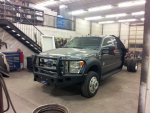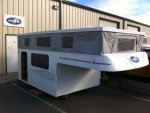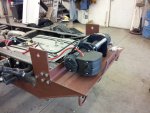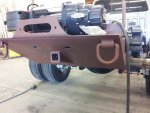Bed being built
Bed construction started. DPF tank moved to right. I'm going to leave the DPF tank on the truck even when I leave the country but remove the exhaust pollution hardware and store it. If I need the OEM exhaust to bring back in to USA I'll ship the exhaust and reattach it thus making it legal in the USA again. I'll put new pipe and muffler where the OEM exhaust pollution hardware is and leave the rest of the OEM exhaust in place. Should be a bolt on/off.
In photo below, floor jack in rear is holding up the winch which will be attached to truck frame but stuffed as high as possible between the truck and bed frames.
Just in front of the winch is a large plate that will be the bed hinge point. Springs will ‘hold down' the front of the bed.
Below the winch we'll have a sloping plate that will help protect the rear Diesel tank and hitch mounted rather high in this sloping plate.
To be built:
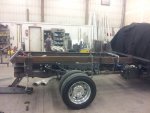
Bed construction started. DPF tank moved to right. I'm going to leave the DPF tank on the truck even when I leave the country but remove the exhaust pollution hardware and store it. If I need the OEM exhaust to bring back in to USA I'll ship the exhaust and reattach it thus making it legal in the USA again. I'll put new pipe and muffler where the OEM exhaust pollution hardware is and leave the rest of the OEM exhaust in place. Should be a bolt on/off.
In photo below, floor jack in rear is holding up the winch which will be attached to truck frame but stuffed as high as possible between the truck and bed frames.
Just in front of the winch is a large plate that will be the bed hinge point. Springs will ‘hold down' the front of the bed.
Below the winch we'll have a sloping plate that will help protect the rear Diesel tank and hitch mounted rather high in this sloping plate.
To be built:
- 30 Gal gasoline tank between truck and bed frame and resting on truck frame above Factory diesel tank.
- 65-85 gal auxiliary Diesel tank between truck and bed frame in front of rear wheels.

Last edited:

